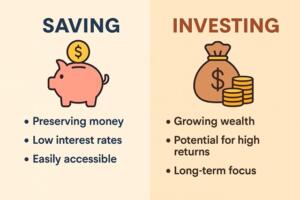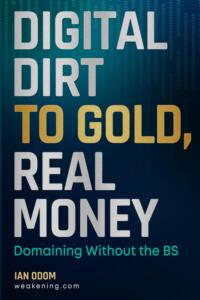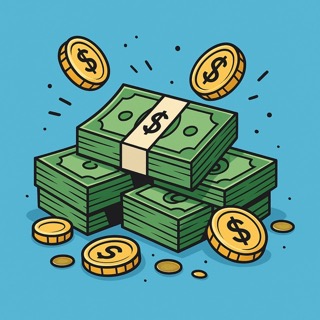
Money in the bank looks safe. It feels nice. But here’s the savage truth: savings accounts won’t make you rich. If your money isn’t moving, growing, and multiplying, it’s slowly dying under inflation.
The real difference between people who build wealth and people who just “get by” isn’t how much they save, it’s how much they invest.
Let’s break it down with facts, funny truths, and a roadmap you can use today.
The Illusion of Saving
Saving is often sold as the ultimate discipline. And yes, saving matters—it’s the foundation of financial security. But here’s the problem:
-
The average savings account in the U.S. earns about 0.45% interest (FDIC, 2023),
-
Inflation has averaged 3% to 4% annually over the last few decades,
-
Translation: your money is losing value every single year while it sits there “safe.”
Savage truth, if you save $10,000 today and never invest it, in 20 years it won’t buy you the same lifestyle—it’ll feel more like $6,000.
Funny analogy, saving without investing is like filling a bucket with water that has a small hole in the bottom. You don’t notice at first, but eventually, you wonder where all the water went.
Investing, Where Wealth Actually Grows
Investing is where money starts working for you instead of you working for it. It’s the difference between stacking coins and planting seeds.
-
The S&P 500 has returned about 10% annually on average since 1926 (Yahoo Finance),
-
$10,000 invested in the stock market 30 years ago is worth over $200,000 today,
-
Real estate investors historically average 8% to 12% returns annually, depending on location and leverage,
The math is simple: investing compounds, saving stalls.
The Power of Compounding
Albert Einstein supposedly called compounding “the eighth wonder of the world.” Whether he said it or not, the math doesn’t lie.
If you save $500 a month at 0.5% interest, in 30 years you’ll have about $185,000.
If you invest $500 a month with 8% annual returns, in 30 years you’ll have about $745,000.
That’s the cost of choosing safety over growth.
Savage truth, compounding doesn’t reward the smartest, it rewards the earliest starters.
Saving vs Investing, What Each Is Actually For
Let’s not kill saving entirely. Both saving and investing have roles, but they serve different purposes.
Saving is for:
-
Emergency funds (3–6 months of expenses),
-
Short-term goals (car, vacation, wedding),
-
Liquidity for opportunities,
Investing is for:
-
Retirement,
-
Wealth building,
-
Passive income,
-
Beating inflation,
Funny line, saving is your “emergency exit.” Investing is your “first-class ticket.”
The Psychology Behind Saving and Investing
-
Savers seek safety, they fear loss more than they desire growth,
-
Investors embrace calculated risk, they know no risk equals no reward,
A Fidelity study (2022) found that the biggest regret retirees had wasn’t “spending too much” it was not investing early enough.
Fear keeps many people stuck as savers, but fear of regret should push you into investing.
Facts That Prove Investing Beats Saving
-
JP Morgan Asset Management (2023): Holding cash long-term underperforms every major asset class,
-
Federal Reserve Data: The wealthiest 10% of households own 89% of stocks and equities,
-
Bankrate Survey: 61% of Americans admit they’re behind on retirement savings because they rely too much on saving instead of investing,
Savage reality, banks get rich off your savings. You don’t.
Common Excuses People Make
“I don’t have enough money to invest.”
Start with $50. Apps like Robinhood or Fidelity let you buy fractional shares. Waiting until you “have enough” is code for procrastination.
“It’s too risky.”
Not investing is riskier. Inflation guarantees loss.
“I’ll start later.”
Later robs you of compounding. $100 invested today at 10% grows to $1,745 in 30 years. Wait 10 years to start, it’s only $673.
Savage punchline, procrastination is more expensive than any stock market dip.
Where to Start Investing
-
Stock Market
-
Index funds (S&P 500, Total Market),
-
Low fees, diversified, historically strong returns,
-
-
Real Estate
-
Rental income, appreciation, leverage benefits,
-
“House hacking” is a proven path for new investors,
-
-
Your Business or Side Hustle
-
Highest ROI potential,
-
Building skills and digital assets compounds over a lifetime,
-
-
Domain Names and Digital Assets
-
Buy undervalued names, hold, and flip at profit,
-
Just like real estate, but online. (See my book The Digital Dirt for more strategies),
-
A Balanced Strategy
The smartest path is using both, but knowing their roles.
-
Save for stability,
-
Invest for growth,
Think of saving as your helmet and investing as your rocket fuel. You need both, but only one gets you to the moon.
If you’re serious about wealth, understand this, saving alone won’t get you there. You can’t penny-pinch your way into prosperity. The only way forward is to put money to work through investing.
Saving keeps you alive. Investing makes you thrive.
At Weakening.com, we remind entrepreneurs, domainers, and hustlers every day the only failure is not getting started.




